Investigation of a Gravel-Bed River’s Pattern Changes: Insights from Satellite Images
Abstract
:1. Introduction
2. Materials and Methods
2.1. Images and Data Detected
2.2. Hydrological Data
2.3. Methods
3. Analysis and Results
3.1. Evolution of the Active Area and of the Vegetation Islands
3.2. Morphological Features and Their Dynamics
4. Discussion
5. Conclusions
- different morphological features form between time periods characterized by frequent low-magnitude events with sporadic high peaks and time periods characterized by frequent high-magnitude events.
- during the time period characterized by frequent low-magnitude events with sporadic high peaks, the active channels are mainly concentrated on one side (left part) of the study reach, where a series of downstream migrating bars form. During the time period characterized by frequent high-magnitude events, the channel tends to assume a single tread meandering pattern characterized by a prevailing lateral migration;
- the difference in the morphological features evolving between the two time periods could be related to the different vegetation distribution and sediment transport mechanisms induced by the floods. The vegetation cover, which always increases on the right part of the study reach, determines a sort of interface between the vegetated-dominated area, where the flow resistance is significant, and the flood-disturbance-dominated area, where the action by flow is significant. Especially during frequent low-magnitude events, interactions between coarse and fine fractions could determine that the coarse particles become more mobile affecting the bed-load transport and the associated migrating features; during the period with frequent high-magnitude events, the ratio of coarse to fine sediments is altered and the gravel material and woody debris are deposited. This furtherly facilitates the formation of vegetation islands in one side and the sediment deposition on the other one, forcing the channel to suppress the secondary channels and assuming a single tread pattern.
Funding
Institutional Review Board Statement
Acknowledgments
Conflicts of Interest
References
- Schumm, S.A. The Fluvial System; John Wiley & Sons: New York, NY, USA, 1977; 338p. [Google Scholar]
- Bridge, J.S. Rivers and Floodplains: Forms, Process, and Sedimentary Record; Blackwell Science: Oxford, UK, 2003; p. 491. [Google Scholar]
- Métivier, F.; Barrier, L. Alluvial landscape evolution: What do we know about metamorphosis of gravel bed meandering and braided streams. In Gravel-Bed Rivers: Processes, Tools, Environments; Church, M., Biron, P., Roy, A., Eds.; Wiley & Sons: Chichester, UK, 2012; Chapter 34; pp. 474–501. [Google Scholar]
- Beechie, T.J.; Lierman, M.; Pollock, M.M.; Baker, S.; Davies, J. Channel Pattern and river-floodplain dynamics in forested mountain river systems. Geomorphology 2006, 78, 124–141. [Google Scholar] [CrossRef]
- Piegay, H.; Grant, G.; Nakamura, F.; Trustrum, N. Braided river management: From assessment of river behavior to improved sustainable development. Braided Rivers Process. Depos. Ecol. Manag. 2006, 36, 257–275. [Google Scholar]
- Zanoni, L.; Gurnell, A.; Drake, N.; Surian, N. Island dynamics in a braided river from analysis of historical maps and air photographs. River Res. Appl. 2008, 24, 1141–1159. [Google Scholar] [CrossRef]
- Zolezzi, G.; Bertoldi, W.; Tubino, M. Morphodynamics of Bars in Gravel-Bed Rivers: Bridging Analytical Models and Field Observations; Chapter 6. Gravel-Bed Rivers: Processes, Tools, Environments; Church, M., Roy, A.G., Biron, P.M., Eds.; John Wiley & Sons: Hoboken, NJ, USA, 2012. [Google Scholar]
- Tockner, K.; Ward, J.V.; Arscott, D.B.; Edwards, P.J.; Kollmann, J.; Gurnell, A.M.; Petts, G.E.; Maiolini, B. The Tagliamento river: A model ecosystem of European importance. Aquat. Sci. 2003, 65, 239–253. [Google Scholar] [CrossRef] [Green Version]
- Nami, M.; Leeder, M.R. Changing channel morphology and magnitude in the scalby formation (middle jurassic) of yorkshire, England. In Fluvial Sedimentology. Vol. 5. Ch. Memoirs of the Canadian Society of Petroleum Geologists; Miall, A.D., Ed.; CSPG Special Publications: Calgary, AB, Canada, 1978; pp. 431–440. [Google Scholar]
- Osterkamp, W.R.; Hedman, E.R. Perennial-Streamflow Characteristics Related to Channel Geometry and Sediment in Missouri River Basin; USGS Professional Paper 1242; US Government Printing Office: Washington, DC, USA, 1982. [Google Scholar]
- Parker, G.; Wilcock, P.; Paola, C.; Dietrich, W.E.; Pitlick, J. Quasi-universal relations for bankfull hydraulic geometry of single-thread gravel-bed rivers. J. Geophys. Res. Earth Surf. 2007, 112, 1–21. [Google Scholar] [CrossRef]
- Gaurav, K.; Métivier, F.; Devauchelle, O.; Sinha, R.; Chauvet, H.; Houssais, M.; Bouquerel, H. Morphology of the Kosi meagfan channels. Earth Syrface Dyn. 2015, 3, 321–331. [Google Scholar] [CrossRef] [Green Version]
- Hooke, J.M.; Redmond, C.E. Causes and nature of river planform change. In Dynamics of Gravel-Bed Rivers; Billi, P., Hey, R.D., Thorne, C.D., Tacconi, P., Eds.; John Wiley and Sons: Chichester, UK, 1992; pp. 549–563. [Google Scholar]
- Huisink, M. Late-glacial sedimentological and morphological changes in lowland river in response to climatic change: The maas, southern netherlands. J. Quat. Sci. 1997, 12, 209–223. [Google Scholar] [CrossRef]
- Nakayama, K.; Ulak, P. Evolution of uvial style in the siwalik group in the foothills of the nepal himalaya. Sediment. Geol. 1999, 125, 205–224. [Google Scholar] [CrossRef]
- Abernethy, B.; Rutherfurd, I.D. The e_ect of riparian tree roots on the mass-stability of riverbanks. Earth Surf. Process. Landforms 2000, 25, 921–937. [Google Scholar] [CrossRef]
- Abernethy, B.; Rutherfurd, I.D. The distribution and strength of riparian tree roots in relation to riverbank reinforcement. Hydrol. Process. 2001, 15, 63–79. [Google Scholar] [CrossRef]
- Perona, P.; Molnar, P.; Crouzy, B.; Perucca, E.; Jiang, Z.; McLelland, S.; Wüthrich, D.; Edmaier, K.; Francis, R.; Camporeale, C.; et al. Biomass selection by floods and related timescales: Part 1. Exp. Obs. Adv. Water Resour. 2012, 39, 85–96. [Google Scholar] [CrossRef]
- Gurnell, A.M.; Petts, G.E.; Hannah, D.M.; Smith, B.P.G.; Edwards, P.J.; Kollmann, J.; Ward, J.V.; Tockner, K. Riparian vegetation and island formation along the gravel-bed Fiume Tagliamento, Italy. Earth Surf. Process. Landf. 2001, 26, 31–62. [Google Scholar] [CrossRef]
- Wetzel, P.R. Tree islands ecosystems of the World. In Tree Islands of the Everglades; Sklar, F.H., van der Valk, A.G., Eds.; Kluwer Academic Publishers: Dordrecht, The Netherlands, 2002; pp. 19–69. [Google Scholar]
- Coremblit, D.; Steiger, J.; Gonzalez, E.; Gurnell, A.M.; Charrier, G.; Darrozes, J.; Dousseau, J.; Julien, F.; Lambs, L.; Larrue, S.; et al. The biogeomorphological life cycle of poplars during the fluvial biogeomorphological succession: A special focus on Populus nigra L. Earth Surf. Process. Landf. 2014, 39, 546–563. [Google Scholar] [CrossRef]
- Wintenberger, C.L.; Rodrigues, S.; Bréhéret, J.-G.; Villar, M. Fluvial islands: First stage of development from nonmigrating (forced) bars and woody-vegetation interactions. Geomorphology 2015, 246, 305–320. [Google Scholar] [CrossRef]
- Métivier, F.; Devaichelle, O.; Chauvet, H.; Lajeunesse, E.; Meunier, P.; Blanckaert, K.; Ashmore, P.; Xhang, Z.; Fan, Y.; Liu, Y.; et al. Geometry of meandering and breided gravel-bed threads from Bayanbulak Grassland, Tianshan, P.R. China. Earth Surf. Dynam. 2016, 4, 273–283. [Google Scholar] [CrossRef] [Green Version]
- Bertoldi, W.; Welber, M.; Gurnell, A.; Mao, L.; Comiti, F.; Tal, M. Physical modelling of the combined effect of vegetation and wood on river morphology. Geomorphology 2015, 246, 178–187. [Google Scholar] [CrossRef]
- Gran, K.B.; Tal, M.; Wartman, E.D. Co-evolution of riparian vegetation and channel dynamics in an aggrading braided river system, Mount Pinatubo, Philippines. Earth Surf. Process. Landf. 2015, 40, 1101–1115. [Google Scholar] [CrossRef]
- Diehl, R.M.; Wilcox, A.C.; Stella, J.C.; Kui, L.; Sklar, L.S.; Lightbody, A. Fluvial sediment supply and pioneer woody seedlings as a control on bar-surface topography. Earth Surf. Process. Landf. 2016, 42, 724–734. [Google Scholar] [CrossRef]
- Mardhiah, U.; Rillig, M.C.; Gurnell, A. Reconstructing the development of sampled sites on fluvial island surfaces of the Tagliamento River, Italy, from historical sources. Earth Surf. Process. Landf. 2014, 40, 629–641. [Google Scholar] [CrossRef]
- Corenblit, D.; Steiger, J.; Charrier, G.; Darrozes, J.; Garófano-Gómez, V.; Garreau, A.; González, E.; Gurnell, A.M.; Hortobágyi, B.; Julien, F.; et al. establishment and fluvial landform construction: Biogeomorphic dynamics within a channelized river. Earth Surf. Process. Landf. 2016, 41, 1276–1292. [Google Scholar] [CrossRef]
- Polvi, L.E.; Wohl, E.; Merritt, D.M. Modeling the functional influence of vegetation type on streambank cohesion. Earth Surf. Process. Landf. 2014, 39, 1245–1258. [Google Scholar] [CrossRef]
- Pasquale, N.; Perona, P. Experimental assessment of riverbed sediment reinforcement by vegetation roots. In Proceedings of the 7th International Conference on Fluvial Hydraulics (River Flow), Lausanne, Switzerland, 3–5 September 2014; Schleiss, A.E.A., Ed.; pp. 553–561. [Google Scholar]
- Edmaier, K.; Crouzy, B.; Perona, P. Experimental characterization of vegetation uprooting by flow. J. Geophys. Res. Biogeosci. 2015, 120, 1812–1824. [Google Scholar] [CrossRef]
- Bertoldi, W.; Zanoni, L.; Tubino, M. Assessment of morphological changes induced by flow and flood pulses in a gravel bed braided river: The Tagliamento River (Italy). Geomorphology 2010, 114, 348–360. [Google Scholar] [CrossRef]
- Comiti, F.; Da Canal, M.; Surian, N.; Mao, L.; Picco, L.; Lenzi, M.A. Channel adjustments and vegetation cover dynamics in a large gravel bed river over the last 200 years. Geomorphology 2011, 125, 147–159. [Google Scholar] [CrossRef]
- Surian, N.; Barban, M.; Ziliani, L.; Monegato, G.; Bertoldi, W.; Comiti, F. Vegetation turnover in a braide driver: Frequency and effectiness of floods of different magnitude. Earth Surf. Process. Landf. 2014, 40, 542–558. [Google Scholar] [CrossRef]
- Johnson, W.C. Tree recruitment and survival in rivers: Influence of hydrological processes. Hydrol. Process. 2000, 14, 16–17. [Google Scholar]
- Camporeale, C.; Ridolfi, L. Riparian vegetation distribution induced by river flow variability: A stochastic approach. Water Resour. Res. 2006, 42, W10415. [Google Scholar] [CrossRef] [Green Version]
- Crouzy, B.; Edmaier, N.K.; Pasquale, P. Perona Impact of floods on the statistical distribution of riverbed vegetation. Geomorphology 2013, 202, 51–58. [Google Scholar] [CrossRef]
- Nakamura, F.; Swanson, F.I.; Wondzell, S.M. Disturbance regimes of stream and riparian systems—A disturbace.cascade perspective. Hydrol. Process. 2000, 14, 2849–2860. [Google Scholar] [CrossRef]
- Gurnell, A.M.; Bertoldi, W.; Corenblit, D. Changing river channels: The roles of hydrological processes, plants and pioneer fluvial landforms in humid temperate, mixed load, gravel bed rivers. Earth-Sci. Rev. 2012, 111, 129–141. [Google Scholar] [CrossRef]
- Mckean, J.; Nagel, D.; Tonina, D.; Bailey, P.; Wright, C.W.; Bohn, C.; Nayegandhi, A. Remote Sensing of Channels and Riparian Zones with a Narrow-Beam Aquatic-Terrestrial LIDAR. Remote. Sens. 2009, 1, 1065–1096. [Google Scholar] [CrossRef] [Green Version]
- Kinzel, P.J.; Wright, C.W.; Nelson, J.M.; Burman, A.R. Evaluation of an experimental LiDAR for surveying a shallow, braided, sand-bedded river. J. Hydraulic Eng. 2007, 133, 838–842. [Google Scholar] [CrossRef] [Green Version]
- McKean, J.; Isaak, D.; Wright, C.W. Stream and riparian habitat analysis and monitoring with a high-resolution terrestrial-aquatic lidar. In Remote Sensing Applications for Aquatic Resource Monitoring; Bayer, J.M., Schei, J.L., Eds.; Pacific Northwest Aquatic Monitoring Partnership Special Publication: Cook, WA, USA, 2009; pp. 7–16. [Google Scholar]
- Gurnell, A.M.; Bertoldi, W.; Francis, R.A.; Gurnell, J.; Mardhiah, U. Understanding processes of island development on an island braided river over timescales from days to decades. Earth Surf. Process. Landf. 2019, 44, 624–640. [Google Scholar] [CrossRef]
- Gurnell, A.; Petts, G.; Hannah, D.; Smith, B.; Edwards, P.; Kollmann, J.; Ward, J.; Tockner, K. Wood storage within the active zone of a large European gravel-bed river. Geomorphology 2000, 34, 55–72. [Google Scholar] [CrossRef]
- Petts, G.E.; Gurnell, A.M.; Gerrard, A.I.; Hannah, D.M.; Smith, B.P.G.; Edwards, P.J.; Kollmann, J.; Ward, J.V.; Tockner, K. Longitudinal variations in exposed riverine sediments: A context for the development of vegetated islands along the Fiume Tagliamento, Italy. Aquat. Conserv. 2000, 10, 249–266. [Google Scholar] [CrossRef]
- Maione, U.; Machne, G. Studio Della Formazione Delle Piene del Fiume Tagliamento; Ecoconsult: Milano, Italy, 1982. (In Italian) [Google Scholar]
- Gurnell, A.M. Channel change on the river dee meanders, 1946–1992, from the analysis of air photographs. Regul. Rivers Res. Manag. 1997, 13, 13–26. [Google Scholar] [CrossRef]
- Ragheb, A. Enhancement of Google Earth Positional Accuracy. Int. J. Eng. Res.Technol. 2015, 4, 627–630. [Google Scholar]
- Karrenberg, S.; Blaser, S.; Kollman, J.; Speck, T.; Edwards, P.J. Root anchorage of saplings and cuttings of woody pioneer species in a riparianenvironment. Funct. Ecol. 2003, 17, 170–177. [Google Scholar] [CrossRef] [Green Version]
- Gran, K.; Paola, C. Riparian vegetation controls on braided stream dynamics. Water Resour. Res. 2001, 37, 3275–3283. [Google Scholar] [CrossRef] [Green Version]
- Murray, A.B.; Paola, C. Modelling the effect of vegetation on channel pattern in bedload rivers. Earth Surf. Process. Landf. 2003, 28, 131–143. [Google Scholar] [CrossRef]
- Tal, M.; Paola, C. Effects of vegetation on channel morphodynamics: Results and insights from laboratory experiments. Earth Surf. Process. Landf. 2010, 35, 1014–1028. [Google Scholar] [CrossRef]
- Yalin, M.S. River Mechanics; Pregamon Press: London, UK, 1992. [Google Scholar]
- Sedláček, J.; Kapustová, V.; Šimíček, D.; Bábek, O.; Sekanina, M. Initial stages and evolution of recently abandoned meanders revealed by multi-proxy methods in the Odra River (Czech Republic). Geomorphology 2019, 333, 16–29. [Google Scholar] [CrossRef]
- Słowik, M. The influence of meander bend evolution on the formation of multiple cutoffs: Findings inferred from floodplain architecture and bend geometry. Earth Surf. Process. Landf. 2016, 41, 626–641. [Google Scholar] [CrossRef]
- Hooke, J. Temporal variations in fluvial processes on an active meandering river over a 20-year period. Geomorphology 2008, 100, 3–13. [Google Scholar] [CrossRef]
- Reid, I.; Frostick, L.E.; Layman, J.T. The incidence and nature of bedload transport during flood flows in coarse-grained alluvial channels. Earth Surf. Process. Landf. 1985, 10, 33–44. [Google Scholar] [CrossRef]
- Whiting, P.J.; Dietrich, W.E.; Leopold, L.B.; Drake, T.G.; Shreve, R.L. Bedload sheets in heterogeneous sediment. Geology 1988, 16, 105–108. [Google Scholar] [CrossRef]
- Cudden, J.R.; Hoey, T.B. The causes of bedload pulses in a gravel channel: The implications of bedload grain-size distributions. Earth Surf. Process. Landf. 2003, 28, 1411–1428. [Google Scholar] [CrossRef]
- Venditti, J.; Nelson, P.; Lamb, M.; Dietrich, W.; Yager, E.; Collins, L. Sediment patches, sediment supply and channel morphology. In River, Coastal and Esturarine Morphodynamics; Parker, G., Garcia, M.H., Eds.; RCEM: London, UK, 2005; pp. 79–90. [Google Scholar]
- Braudrick, C.A.; Dietrich, W.E.; Lieverich, G.T.; Sklar, L.S. Experimental evidence for the conditions to sustain meandering in coarse-bedded rivers. Proc. Natl. Acad. Sci. USA 2009, 106, 16936–16941. [Google Scholar] [CrossRef] [Green Version]
- Termini, D. Momentum transport and bed shear stress distribution in a meandering bend: Experimental analysis in a laboratory flume. Adv. Water Resour. 2015, 81, 128–141. [Google Scholar] [CrossRef]
- Van Dijk, W.M.; Van De Lageweg, W.I.; Kleinhans, M.G. Experimental meandering river with chute cutoffs. J. Geophys. Res. Space Phys. 2012, 117, 03023. [Google Scholar] [CrossRef] [Green Version]
- Termini, D.; Piraino, M. Experimental analysis of cross-sectional flow motion in a large amplitude meandering bend. Earth Surf. Process. Landf. 2010, 36, 244–256. [Google Scholar] [CrossRef]
- Bai, R.; Zhu, D.; Chen, H.; Li, D. Laboratory Study of Secondary Flow in an Open Channel Bend by Using PIV. Water 2019, 11, 659. [Google Scholar] [CrossRef] [Green Version]
- Engel, F.L.; Rhoads, B.L. Interaction among mean flow, turbulence, bed morphology, bank failures and channel planform in an evolving compound meander loop. Geomorphology 2012, 163–164, 70–83. [Google Scholar] [CrossRef]


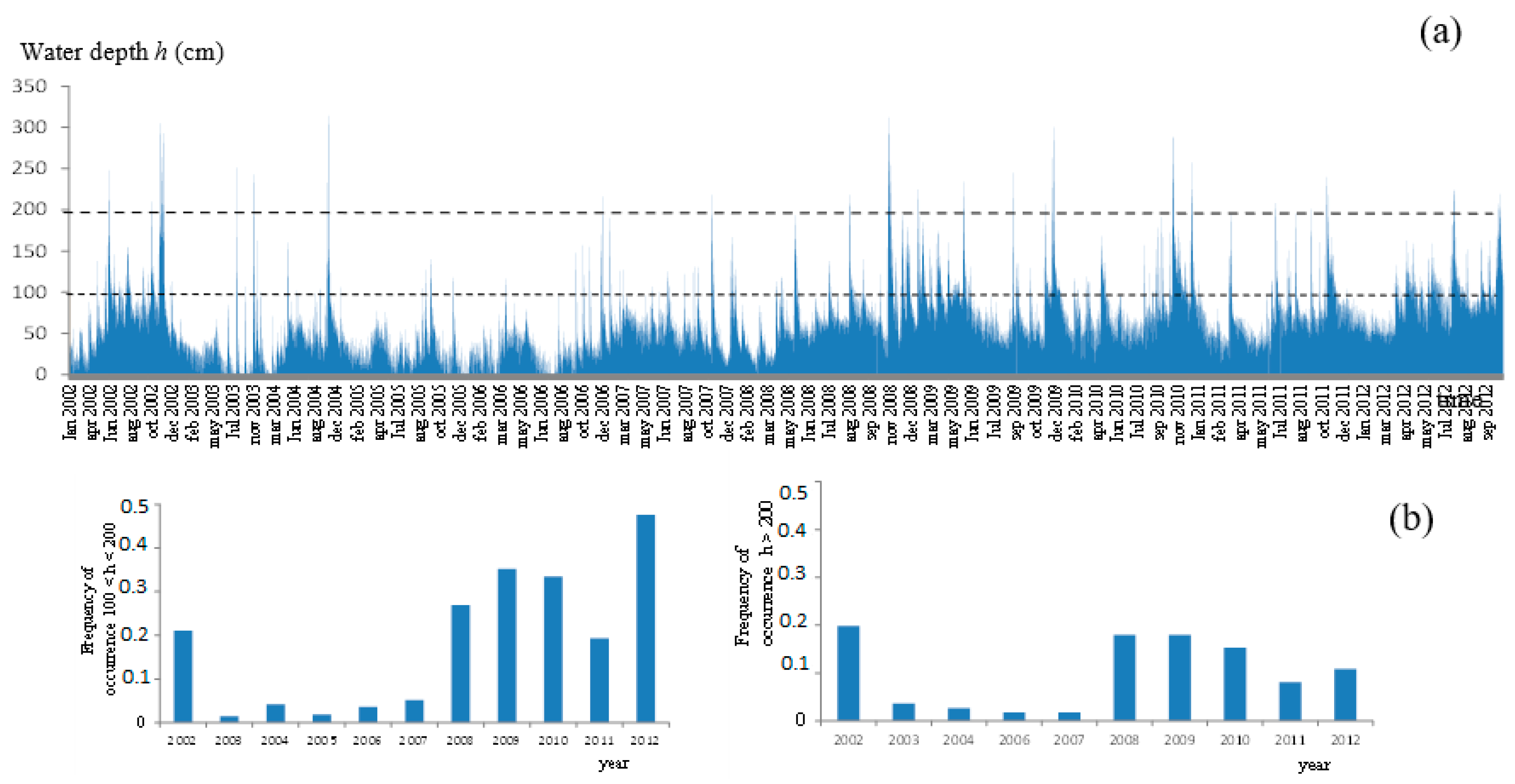
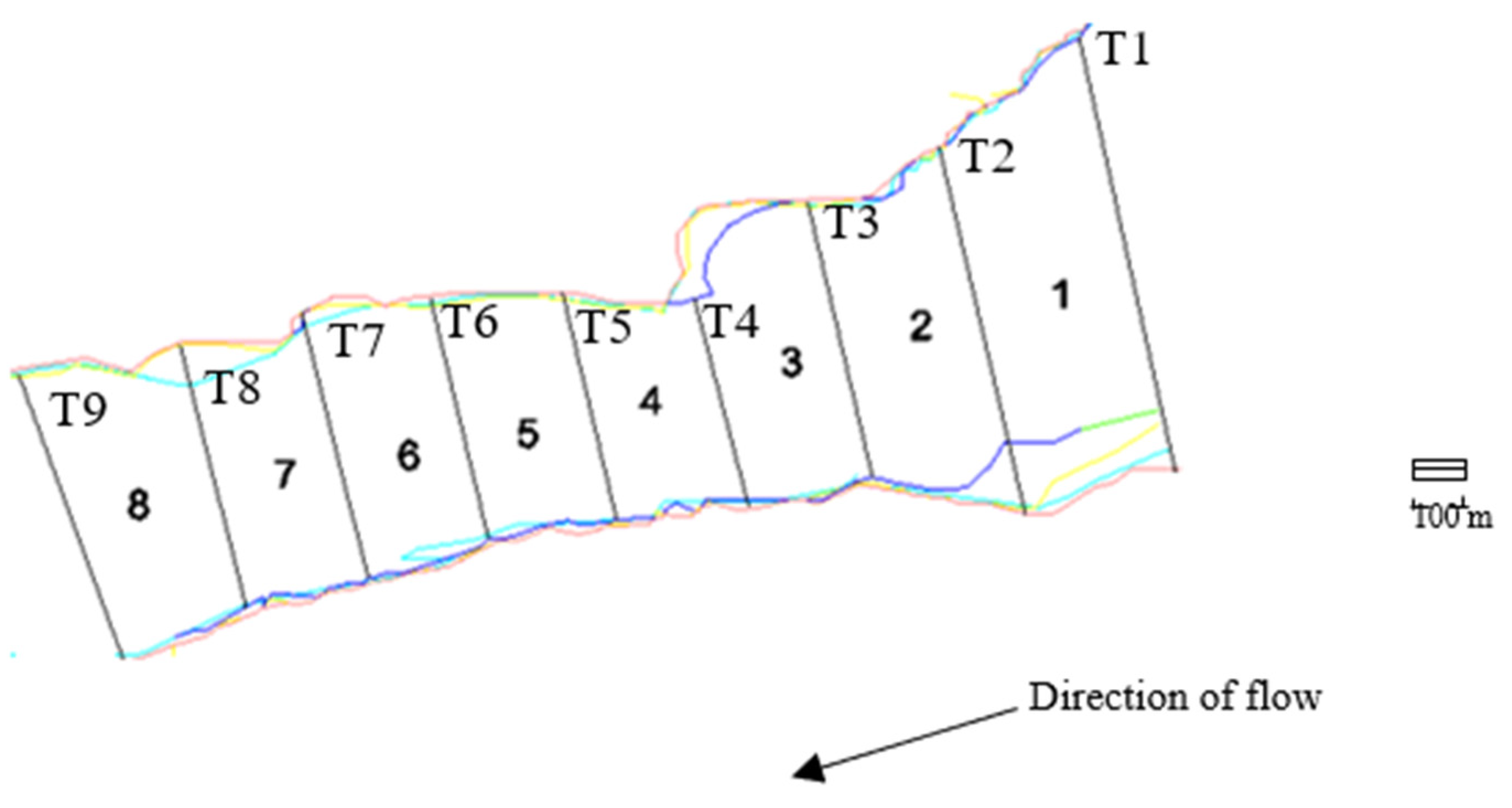
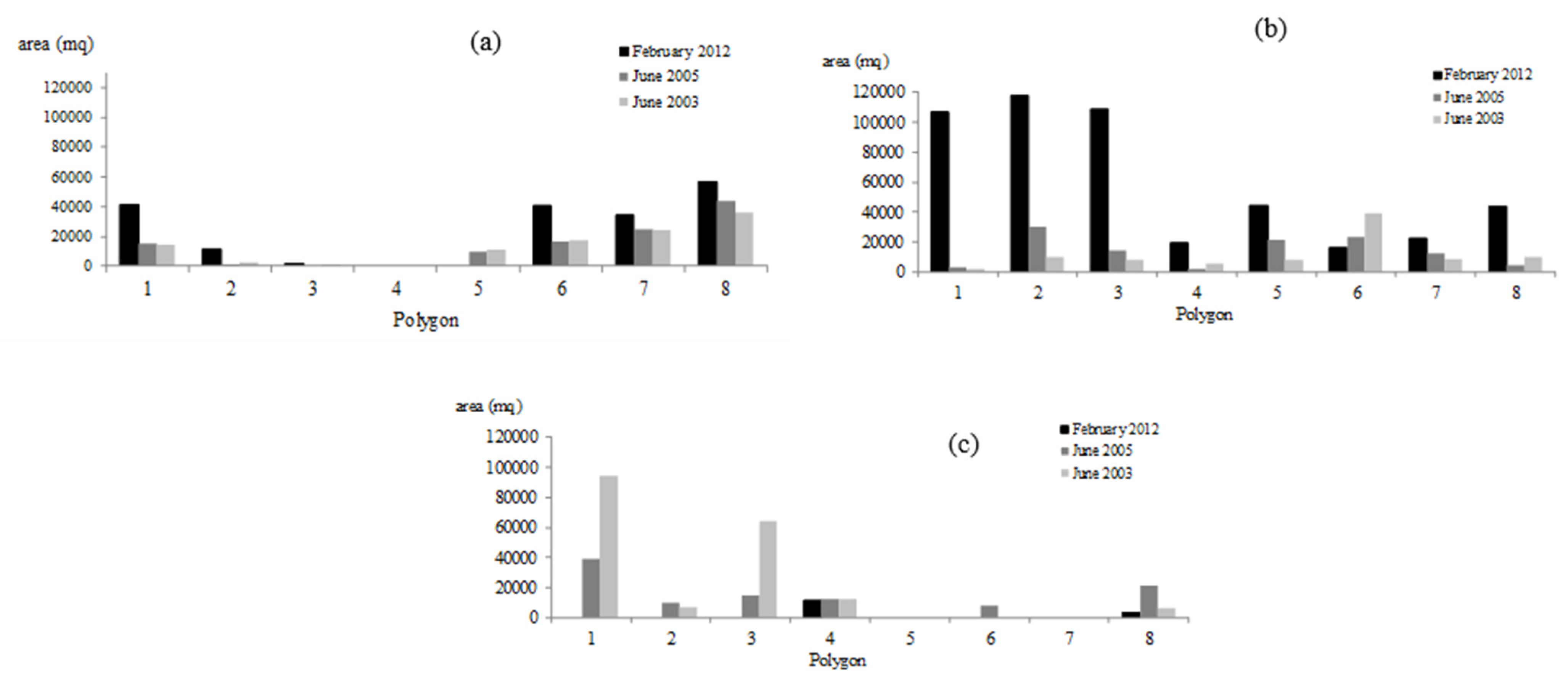
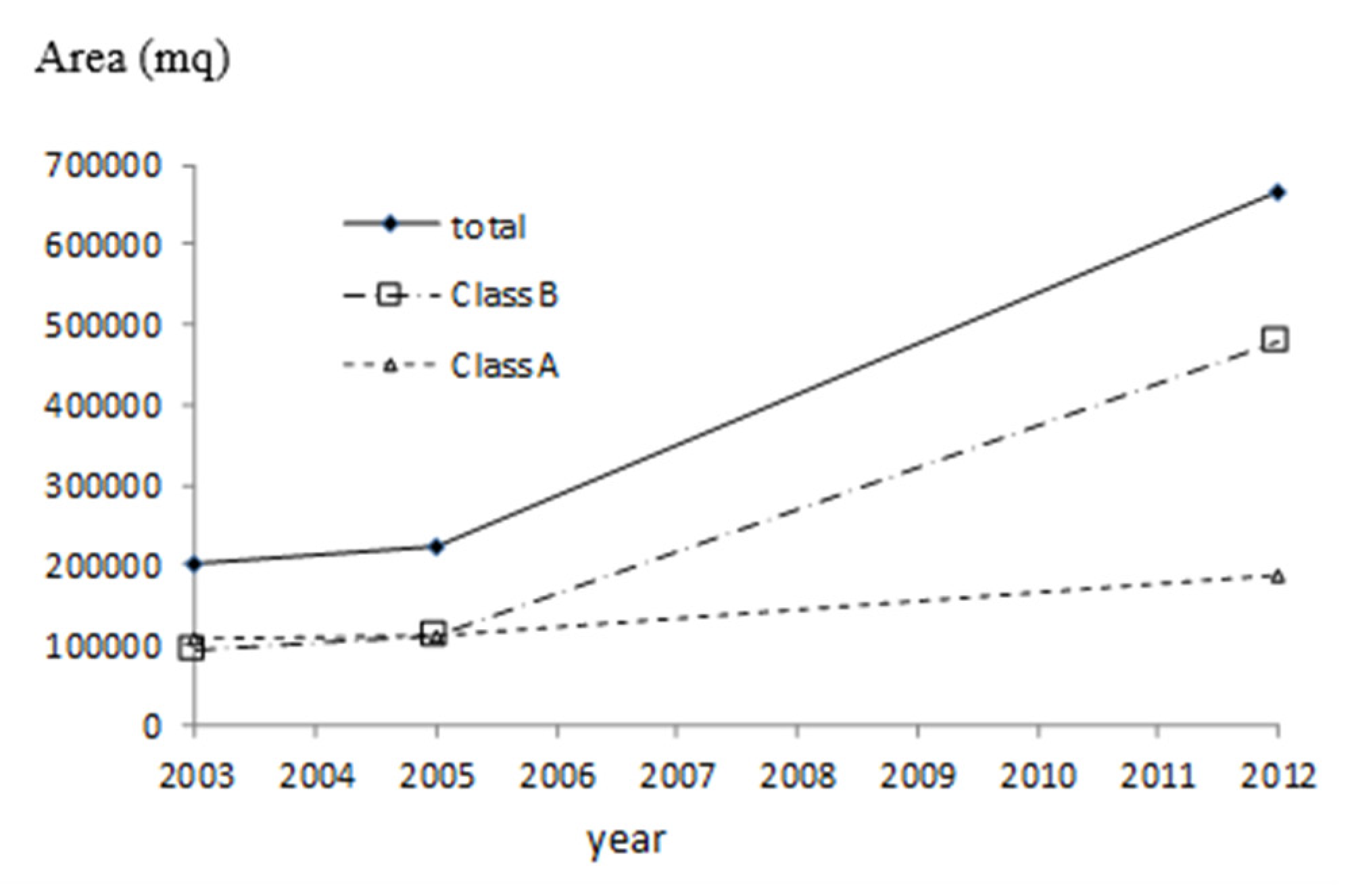
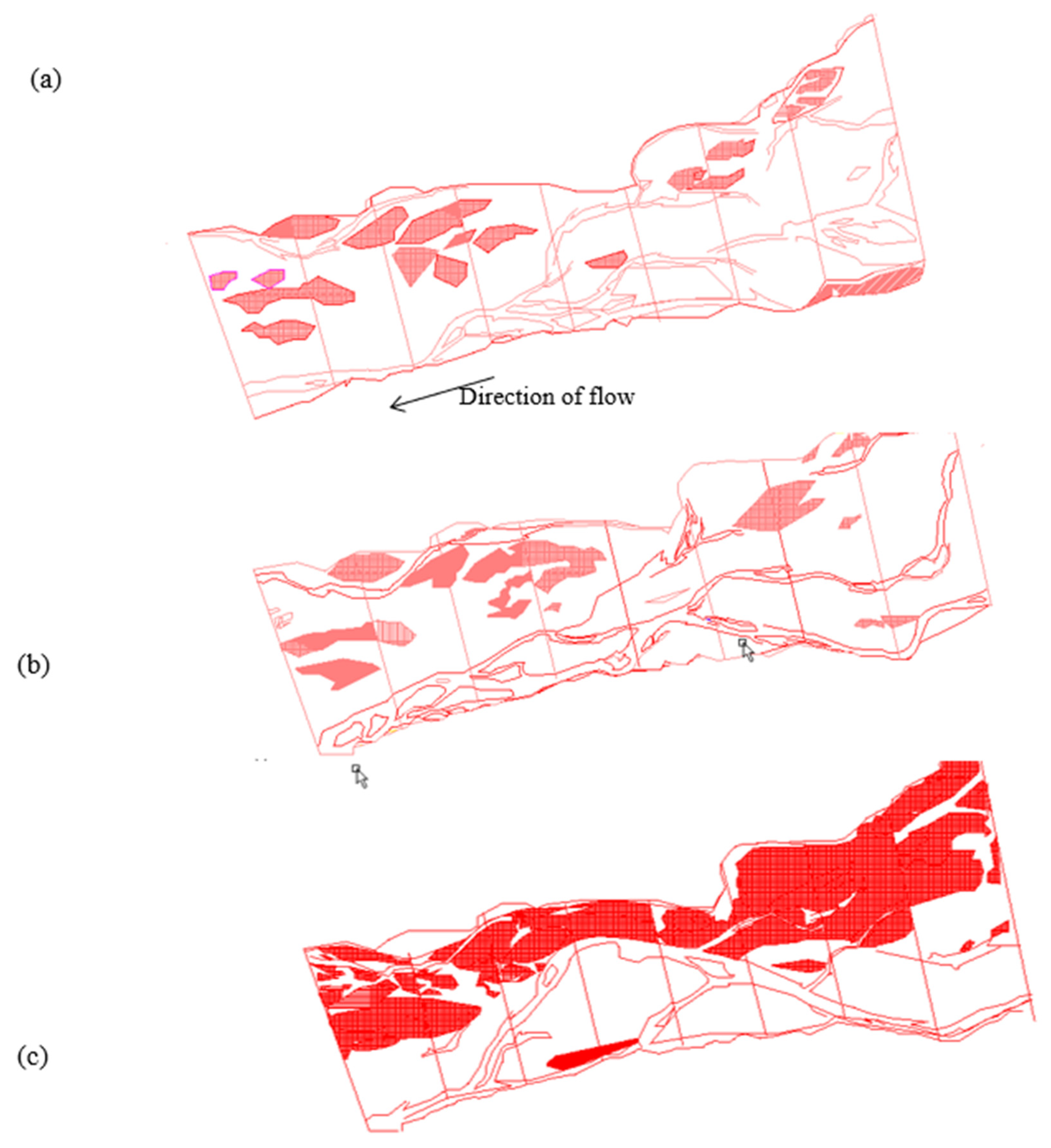

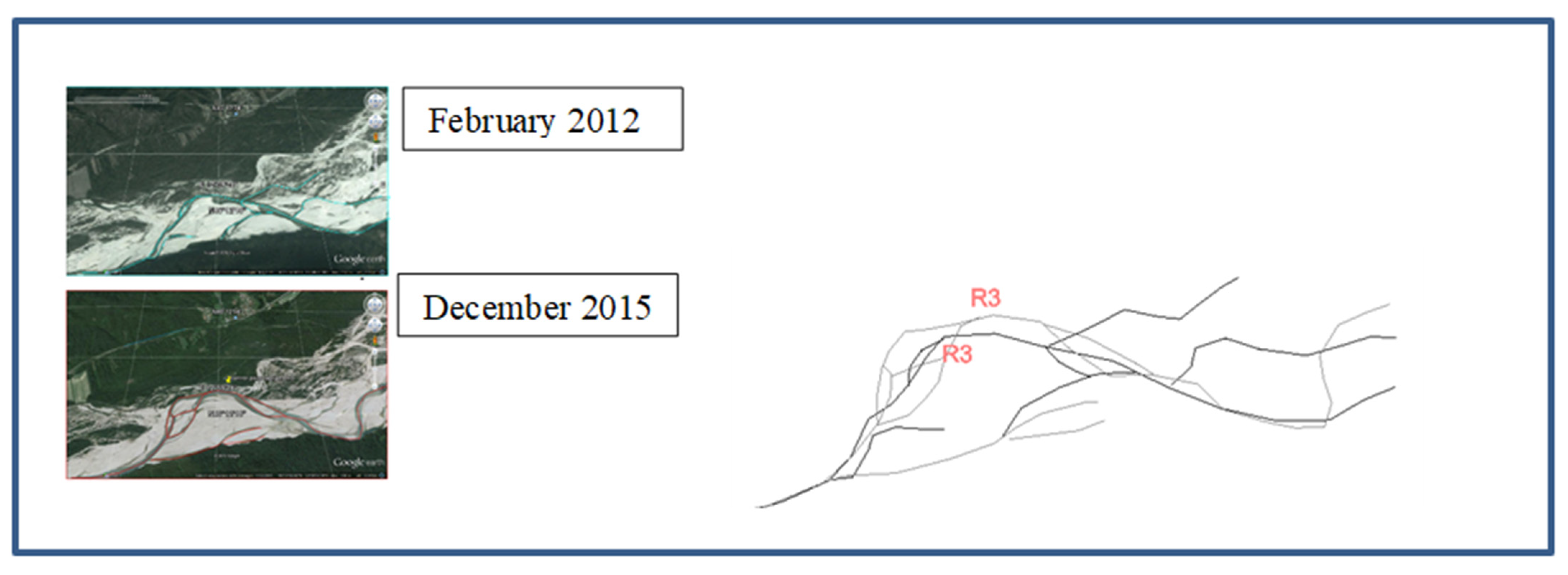
| N. polygon | Class A | Class B | |
| % | % | ||
| June 2003 | 1 | 0.008 | 0.006 |
| 2 | 0.001 | 0.039 | |
| 3 | 0.001 | 0.039 | |
| 4 | 0.000 | 0.035 | |
| 5 | 0.006 | 0.044 | |
| 6 | 0.010 | 0.185 | |
| 7 | 0.014 | 0.043 | |
| 8 | 0.020 | 0.040 | |
| N. polygon | Class A | Class B | |
| % | % | ||
| June 2005 | 1 | 0.009 | 0.008 |
| 2 | 0.001 | 0.111 | |
| 3 | 0.000 | 0.062 | |
| 4 | 0.000 | 0.011 | |
| 5 | 0.006 | 0.117 | |
| 6 | 0.009 | 0.115 | |
| 7 | 0.014 | 0.060 | |
| 8 | 0.025 | 0.018 | |
| N. polygon | Class A | Class B | |
| % | % | ||
| February 2012 | 1 | 0.024 | 0.275 |
| 2 | 0.006 | 0.445 | |
| 3 | 0.001 | 0.466 | |
| 4 | 0.000 | 0.116 | |
| 5 | 0.000 | 0.237 | |
| 6 | 0.023 | 0.081 | |
| 7 | 0.020 | 0.124 | |
| 8 | 0.032 | 0.181 |
Publisher’s Note: MDPI stays neutral with regard to jurisdictional claims in published maps and institutional affiliations. |
© 2021 by the author. Licensee MDPI, Basel, Switzerland. This article is an open access article distributed under the terms and conditions of the Creative Commons Attribution (CC BY) license (http://creativecommons.org/licenses/by/4.0/).
Share and Cite
Termini, D. Investigation of a Gravel-Bed River’s Pattern Changes: Insights from Satellite Images. Appl. Sci. 2021, 11, 2103. https://doi.org/10.3390/app11052103
Termini D. Investigation of a Gravel-Bed River’s Pattern Changes: Insights from Satellite Images. Applied Sciences. 2021; 11(5):2103. https://doi.org/10.3390/app11052103
Chicago/Turabian StyleTermini, Donatella. 2021. "Investigation of a Gravel-Bed River’s Pattern Changes: Insights from Satellite Images" Applied Sciences 11, no. 5: 2103. https://doi.org/10.3390/app11052103






